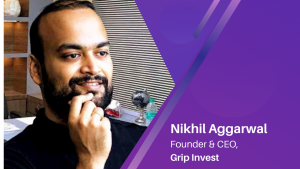Nikhil Aggarwal, Founder & CEO, Grip Invest reveals the business model that is spurring growth and expansion:

Ravi Lalwani: Who are your main customers for inventory financing? From which Indian cities are you receiving good responses for inventory financing?
Nikhil Aggarwal: Inventory finance, unlike lease finance, is a short-term, asset-backed investment. Our main investor persona is of someone of 25-40, working professionals, with a salary of 1.5+ million. These users have portfolios in mutual funds and fixed deposits and are now seeking opportunities to diversify for higher risk-adjusted returns. With inventory finance, the investor can get started with the new-age asset-backed investment without a long-term commitment. Being a digital platform, we have received visitors from over 1300 cities in India. We’ve had the highest number of investors from Mumbai, Delhi, Hyderabad, Kolkata and Chennai.
We have leased assets to over 75+ customers is a variety of industries such as mobility, health care, cloud kitchen, eCommerce, logistics, warehousing, etc. EVs have now become synonymous with the future of mobility in India, and Grip is keen on driving this green mobility movement. EVs and charging infra is the second biggest contributor to our overall portfolio, and we expect it to grow within our inventory finance portfolio as well.
What is the size of the inventory financing business in India? What is your company’s share in it?
A report by CRIF High Mark stated that the Indian commercial lending market (invoice-based lending, crowd funding, inventory financing, etc) as of March 2021 is at Rs76.8 trillion and has grown 93% between FY17 and FY21. The total market growth potential for India’s digital lending sector between 2021-2023 is approximately $820 billion – which will be 48% of all lending transactions by 2023. Grip is the market leader in India when it comes to fractional inventory financing investment opportunities. Grip’s inventory financing model is unique as it allows retail investors to be part of the inventory financing deal as a fractional asset owner.
What technology systems are you using to run the business?
We are a digital-first organization and are completely cloud-native for our infrastructure which is powered by Amazon Web Services. To provide a personalized experience to our 150,000+ strong community of investors, we are using an in-house business intelligence and an omni-channel customer platform that enables us to visualize various investors’ journeys and provide a personalized cross-channel customer experience across platforms.
Please share name of some customers? How is your model different from your competitors?
Leasing is a sustainable option for companies whose operations are dependent on heavy capital investments involving many physical assets. Mobility companies – that account for half the global equipment leasing market – are the best example. Overall, we’ve facilitated the leasing of assets worth Rs1.5 billion to some of India’s most disruptive businesses, including Udaan, Stanza Living, Furlenco, Bounce, Blue Tokai, Everest Fleet, IPLElectric, FabAlley, and LetsTransport as our partners. So far, we’ve enabled 75+ companies to access a different channel of growth capital.
For investors, lease investing is an excellent diversification tool in a portfolio since it is a non-market linked asset-backed investment avenue. Investors participating in leasing are normally taking a corporate credit exposure and receiving returns monthly. Grip has so far offered lease investment opportunities across 100+ investment deals to its 150,000+ users (consisting of resident and non-resident Indians), making it one of the largest lease investment platforms in the country. We have so far returned over Rs300 million to our investors with zero default in payments.
There are several platforms offering new forms of investment, and we consider them to be our key competitors. These include companies like KredX, Klubworks, and Wint Wealth. Globally, YieldStreet in the US is a path leader in this product with 250,000 investors and $1.3 billion in capital invested.
We are different from our competitors as: (i) None of them offer leasing as a product and most of the products they offer are unsecured. (ii) We can provide a lower minimum investment size. (iii) We are an industry first in a variety of customer experience touchpoints and digital features. These differentiations have resulted in Grip having a very loyal and dedicated investor base. Over 40% of our investors have invested in Grip at least twice and the average ticket size is 4X the minimum amount on the website.
What is your business strategy for tier 3 cities?
Our small ticket size, attractive offerings, along strong digital push has enabled us to get users from over 1300 cities in India on our platform. Due to the ongoing pandemic and WFH movement within the Indian sector, the talent and millennials are scattered across India, instead of just tied down to a few pockets in India. Our focus now is to ensure that we pick up the baton of educating the masses about the benefits of alternative investments and drive further adoption.






